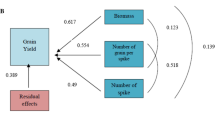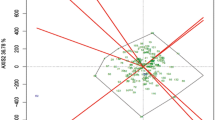Abstract
Drought tolerance as such is often not considered to be an independent trait by plant breeders. The objective of this study was to evaluate eight drought tolerance indices, namely stress susceptibility index (SSI), yield stability index (YSI), yield reduction ratio (Yr), yield index (YI), tolerance index (TOL), mean productivity (MP), geometric mean productivity (GMP), and stress tolerance index (STI) in upland cotton (G. hirsutum L.) genotypes. For this purpose, 16 genotypes were sampled during the 2013-2014 growing seasons under both normal and drought-stress field conditions at the Main Cotton Research Station of Navsari Agricultural University, Surat, India. The drought tolerance indices were calculated based on seed cotton yield under drought stress and non-stress conditions. Mean comparison of drought tolerance indices and seed cotton yield validated the significant influences of drought stress on yield as well as significant differences among genotypes. Results of calculated correlation coefficients and multivariate analyses showed that GMP, MP and STI indices were able to discriminate drought-sensitive and tolerant genotypes. Cluster analysis using the drought-tolerance indices divided the 16 genotypes into tolerant and susceptible groups. Two genotypes, G.Cot.16 × H-1353/10 and H-1353/10 × G.Cot.16 gave good yield response under drought conditions leading to their stability during water stress conditions. Based on multivariate analyses using the indices individually or in combinations, it was possible to identify the most yield-stable genotypes across the environments. Overall, we concluded that GMP, MP and STI indices can be efficiently exploited not only for screening drought tolerance but also to identify superior genotypessuitable for both stress and non-stress field conditions.
Similar content being viewed by others
References
Blum A. 1996. Crop responses to drought and the interpretation of adaptation. Plant Growth Regul. 20:135–148
Bouslama M, Schapaugh WT. 1984. Stress tolerance in soybean. Part 1: evaluation of three screening techniques for heat and drought tolerance. Crop Sci. 24: 933–937
Ball RA, Oosterhuis DM, Maromoustakos A. 1994. Growth dynamics of the cotton plant during water-deficit stress. Agron. J. 86:788–795
Cabello R, Mendiburu FD, Monneveux P, Bonierbale M. 2013. Comparison of yield based drought tolerance indices in improved varieties, genetic stocks and landraces of potato (Solanum tuberosum L.). Euphytica 193:147–156
Clarke JM, De Pauw RM, Townley-Smith TM. 1992. Evaluation of methods for quantification of drought tolerance in wheat. Crop Sci. 32:728–732
Dehghani GH, Malekshhi F, Alizadeh B. 2009. A study of drought tolerance indices in canola (Brassica napus L.) genotypes. J. Sci.Technol. Agri. Natural Reso. 13:77–90
Ennahli S, Hugh JE. 2005. Physiological limitations to photosynthetic carbon assimilation in cotton under water stress. Crop Sci. 45:2374–2382
Fischer AT, Maurer R. 1978. Drought resistance in spring wheat cultivars. I. Grain yield responses. Aust. J. Agric. Res. 29: 897–912
Fernandez GCJ. 1992. Effective selection criteria for assessing plant stress tolerance. In: C.G. Kuo, editor, Adaptation of Food Crops to Temperature and Water Stress: Proceedings of an International Symposium, Taiwan. 13-18 Aug. 1992. Asian Vegetable Res. and Dev. Ctr., Shanhua, Tainan, pp 257–270
Golabadi M, Arzani A, Mirmohammadi SAM. 2006. Assessment of drought tolerance in segregating populations in durum wheat. Afr. J. Agric. Res. 1:162–171
Golestani-Araghi S, Assad MT, 1998. Evaluation of four screening techniques for drought resistance and their relationship to yield reduction ratio in wheat. Euphytica 103: 293–299
Gavuzzi P, Rizza F, Palumbo M, Campaline RG, Ricciardi GL, Borghi B. 1997. Evaluation of field and laboratory predictors of drought and heat tolerance in winter cereals. Can. J. Plant Sci. 77:523–531
Guttieri MJ, Stark JC, Brien KO, Souza E. 2001. Relative sensitivity of spring wheat grain yield and quality parameters to moisture deficit. Crop Sci. 41:327–335
Han HL, Kang FJ. 2001. Experiment and study on effect of moisture coerce on cotton producing. Trans. CSAE 17: 37–40
Jafari A, Paknejad F, Jami Al-Ahmadi M. 2009. Evaluation of selection indices for drought tolerance of corn (Zea mays L.) hybrids. Inter. J. Plant Prod. 3:33–38
Karimizadeh R, Mohammadi M, Ghaffaripour S, Karimpour F, Shefazadeh MK. 2011. Evaluation of physiological screening techniques for drought-resistant breeding of durum wheat genotypes in Iran. Afr. J. Biotechnol. 10:12107–12117
Kaya Y, Palta C, Taner S. 2002. Additive main effects and multiplicative interactions analysis of yield performances in bread wheat genotypes across environments. Turkish J. Agric. For. 26: 275–279
Khalili M, Naghavi MR, Pour AR, Talebzadeh J. 2012. Evaluating of drought stress tolerance based on selection indices in spring canola cultivars (Brassica napus L.). J. Agri. Sci. 4: 78–85
Khodarahmpour Z, Choukan R, Bihamta MR, Hervan EM. 2011. Determination of the best heat stress tolerance indices in maize (Zea mays L.) inbred lines and hybrids under Khuzestan Province conditions. J. Agric. Sci. Technol. 13: 111–121
Kristin AS, Senra RR, Perez FI, Enriquez BC, Gallegos JAA, Vallego PR, Wassimi N, Kelley JD. 1997. Improving common bean performance under drought stress. Crop Sci. 37: 43–50
Majidi MM, Tavakoli V, Mirlohi A, Sabzalian MR. 2011. Wild safflower species (Carthamus Oxyacanthus Bieb.): A possible source of drought tolerance for arid environments. Aust. J. Crop Sci. 5: 1055–1063
Mitra J. 2001. Genetics and genetic improvement of drought resistance in crop plants. Curr. Sci. 80:758–762
Mohammadi M, Karimizadeh R, Abdipour M. 2011. Evaluation of drought tolerance in bread wheat genotypes under dryland and supplemental irrigation conditions. Aust. J. Crop. Sci. 5: 487–493
Pantuwan G, Fukai S, Cooper M, Rajatasereekul S, O’Toole JC. 2002. Yield response of rice (Oryza sativa L.) genotypes to different types of drought under rainfed lowlands. Part 1: Grain yield and yield components. Field Crop Res 73: 153–168
Pettigrew WT. 2001. Environmental effects on cotton fiber carbohydrate concentration and quality. Crop Sci. 41: 1108–1113
Pospisilova J, Synkova H, Rulcova J. 2000. Cytokinins and water stress. Bio. Planta. 43: 321–328
Potikha TS, Collins CC, Johnson DI, Delmer DP, Levine A. 1999. The involvement of hydrogen peroxide in the differentiation of secondary walls in cotton fibers. Plant Physiol. 119: 849–858
Reynolds MP, Mujeeb-Kazi A, Sawkins M. 2005. Prospects for utilizing plant-adaptive mechanisms to improve wheat and other crops in drought-and salinity-prone environments. Ann. App. Bio. 146: 239–259
Rajmani A. 1994. Screening Gossypium hirsutum genotypes for drought tolerance. Madras Agric. J. 81:465–468
Ramirez P, Kelly J. 1998. Traits related to drought resistance in common bean. Euphytica 99: 127–136
Rosielle AA, Hamblin J. 1981. Theoretical aspect of selection for yield in stress and non-stress environment. Crop Sci. 21: 943–946
Salisbury FB, Ross C. 1992. Plant Physiology, Ed 4, Wadsworth, Belmont, CA, USA Sio-Se
Mardeh A, Ahmadi A, Poustini K, Mohammadi V. 2006. Evaluation of drought resistance indices under various environmental conditions. Field Crop Res. 98: 222–229
Subbarao GV, Johansen C, Slinkard AE, Rao RCN, Saxena NP, Chauhan YS. 1995. Strategies and scope for improving drought resistance in grain legumes. Crit. Rev. Plant Sci. 14: 469–523
Talebi R, Fayaz F, Naji N. 2009. Effective selection criteria for assessing drought stress tolerance in durum wheat (Triticum durum Desf.). Gen. Appl. Plant Physiol. 35:64–74
Toorchi M, Naderi R, Kanbar A, Shakiba MR. 2011. Response of spring canola cultivars to sodium chloride stress. Ann. Bio. Res. 2: 312–322.
Ullah I, Zafar Y. 2006. Genotypic variation for drought tolerancein cotton (Gossypium hirsutum L.): seed cotton yield responses. Pak. J. Bot. 38:1679–1687.
Wiggins MS, Leib BG, Mueller TC, Main CL. 2013. Investigation of physiological growth, fiber quality, yield, and yield stability of upland cotton varieties in differing environments. J. Cotton Sci. 17:140–148.
Yadav OP, Bhatnagar SK. 2001. Evaluation of indices for identification of pearl millet cultivars adapted to stress and non-stress conditions. Field Crops Res. 70:201–208.
Author information
Authors and Affiliations
Corresponding author
Rights and permissions
About this article
Cite this article
Singh, C., Kumar, V., Prasad, I. et al. Response of upland cotton (G.hirsutum L.) genotypes to drought stress using drought tolerance indices. J. Crop Sci. Biotechnol. 19, 53–59 (2016). https://doi.org/10.1007/s12892-015-0073-1
Received:
Revised:
Accepted:
Published:
Issue Date:
DOI: https://doi.org/10.1007/s12892-015-0073-1




